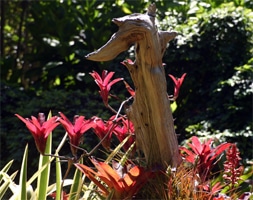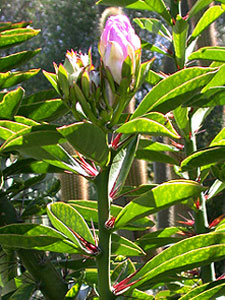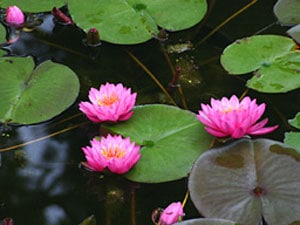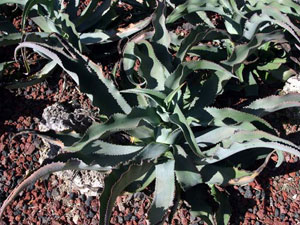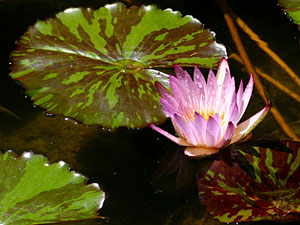
Plant Highlights
Plant Highlights
-
Euphorbia mammillaris ‘Variegata’
variegated corn cob euphorbia
Highlight Month:
August
Nativity:
Garden Origin
Growth Habit:
The corn cob euphorbia is a small, branching succulent plant. It grows only about 6 to 8 inches tall.
Growing Requirements:
Like all succulent euphorbias, this species requires excellent drainage and a sunny location.
Features:
Called the corn cob euphorbia because it has a knobby surface, this variegated form is pale green most of the year. The tips become noticeably pink in cooler weather or when the plant is under other stressful conditions.
Where at Lotusland:
Among the amethyst chunks on the west side of the Main Drive.
-
Neoregelia ‘Fireball’
Highlight Month:
August
Nativity:
Garden Origin
Growth Habit:
This is a dwarf bromeliad with rosettes of leaves up to six inches across. It grows epiphytically and in the garden should be mounted on a branch or planted in a hanging basket.
Growing Requirements:
For brightest color, plant in sun or partial shade. Keep moist by filling the “cups” of its leaves with water. Hardy to 30 degrees only.
Features:
The fiery red leaves of each rosette and its habit of sending out offsets in all directions are captured in its name, ‘Fireball’
Where at Lotusland:
In the Lower Bromeliad Garden, mounted on driftwood or tree trunks.
-
Highlight Month:Aloe mitriformis
August
Nativity:
South Africa
Growth Habit:
The stems of this succulent aloe trail along the ground, often rooting where they touch down. The leaves are short and broad in a rosette and are edged in sturdy teeth.
Growing Requirements:
Full sun and good drainage are required to grow this aloe. It is hardy to 20 – 25 degrees. Drought tolerant.
Features:
The yellow teeth along the edges contrast nicely with the deep green of the leaves. In summer, the coral colored flower heads are very showy. This plant has been known by several names including Aloe distans and Aloe perfoliata. Aloe mitriformis is listed in the recent Aloes: The Definitive Guide.
Where at Lotusland:
In the Aloe Garden
-
Iochroma coccinea and Iochroma cyaneum
Highlight Month:
September
Nativity:
There are around 20 species of Iochroma, native to Central and South America.
Growth Habit:
The two species of Iochroma growing at Lotusland are shrubby perennials 8-10 feet tall. They can be trained as a small tree or pruned into a rounder shrub form. The flowers are borne on the new growth, so prune stems back at the end of the blooming season to promote next year’s flower production.
Growing Requirements:
Plant in full sun to partial shade. Iochroma are not drought-tolerant and require regular watering during the summer months.
Features:
Iochroma have 3 inch long tubular flowers that hang down from the branches. They flower from spring through fall, or sometimes year round in warm-winter areas.
Where at Lotusland:
There are both red-flowered (Iochroma coccinea) and blue-flowered (Iochroma cyaneum) species growing in the Fern Garden.
-
Araucaria bidwillii
bunya-bunya, bunya pine
Highlight Month:
September
Nativity:
Queensland, Australia
Growth Habit:
An evergreen coniferous tree which can reach up to 100 feet tall. Younger trees have a distinctive conical shape, which becomes rounded with age as the lower branches drop. They make beautiful shade trees with enough space, though the large cones and fallen spiny dried branchlets make them hazardous in areas with pedestrians. At Lotusland, the cones are removed by arborists every year to ensure no one is injured below.
Growing Requirements:
Grows in full sun to partial shade; needs regular watering. Young plants make good container specimens outdoors and also indoors, as they are able to grow well in low light.
Features:
Bunya-bunya have two types of foliage. The younger or understory needles are narrow, glossy green with a point and are arranged in two rows. Mature leaves are stiff with very sharp points and spirally arranged around the branchlets. A. bidwillii produces very large, spiny female cones up to 2 feet long and 1 foot wide, weighing 10 – 15 pounds. The cones take two years to mature, and each contains up to a hundred seeds. The large seeds are a food source for aboriginal Australian peoples.
Where at Lotusland:
There are five A. bidwillii at Lotusland growing in the Japanese Garden and the Blue Garden.
-
Pereskia grandifolia
rose cactus
Highlight Month:
September
Nativity:
Native to Brazil and commonly found north through Mexico.
Growth Habit:
A sprawling shrub growing 15 ft tall. Deciduous in cool winter climates. It is easily propagated from cuttings or seeds.
Growing Requirements:
Grows in full sun or partial shade. It needs well-drained soil but more water than most cacti, especially during the summer growing season.
Features:
Pereskia is a genus in the cactus family that is unusual in having large leaves as well as spines. P. grandifolia has pink or white rose-like flowers which are followed by pear-shaped green fruit.
Where at Lotusland:
The rose cactus grows in the Cactus Garden, along with several other types of Pereskia.
-
Nymphaea species
waterlily
Highlight Month:
September
Nativity:
Garden Origin
Growth Habit:
Hardy and tropical waterlilies grow in lakes and ponds in shallow water from 2 to 6 feet deep. Hardy types go dormant and remain in the pond year round. Tropical varieties are mostly treated as annuals outside the tropics, although they may be over-wintered in a warm tank.
Growing Requirements:
Waterlilies are rooted in the mud in nature, so they require planters or pots in a water garden. Use good soil without organic amendments and plant in full sun.
Features:
Waterlilies provide a nearly unlimited spectrum of colorful flowers in the water garden. Hardy varieties occur in white, pink, red, yellow and shades of orange. Tropicals are more electric and include the above colors as well as blue and purple. There are some tropical varieties that bloom at night, opening in late afternoon and closing by mid-morning. All others bloom during the day.
Where at Lotusland:
In the Water Garden ponds adjacent to the original swimming pool (now the lotus pond) and in the Japanese Garden pond.
-
Agave gypsophila
gypsum century plant
Highlight Month:
September
Nativity:
Mexico
Growth Habit:
Medium sized rosette of narrow, recurved leaves, two to three feet across. The wavy margins are dotted with soft spines. Overall appearance is chalky gray.
Growing Requirements:
Agaves generally require well-drained soil and full sun. Although this species is native to regions with calcareous soils, it grows well in most soil types.
Features:
Like all agaves, this species flowers at the end of an individual plant’s life cycle. The very tall inflorescences bear bright orange clusters of flowers that produce copious nectar. Although the mother plant dies after flowering, many “pups” or offsets are produced at the base.
Where at Lotusland:
Just off the Main Drive on the path leading down to the Water Garden.
-
Nymphaea ‘Madame Ganna Walska’
Highlight Month:
September
Nativity:
Garden Origin
Growth Habit:
This is a tropical, day-blooming waterlily. Tropical waterlily species and selections only thrive in the tropics or ponds that are warm year round. Only reluctantly can they be coaxed into going dormant and in cool weather climates they typically are grown as annuals.
Growing Requirements:
All waterlilies are rooted in soil and in cultivation in ponds are grown in large planting containers filled with soil containing no organic material. Most are heavy feeders and require plenty of balanced fertilizer to grow lushly and bloom well. Tropical waterlilies may be over-wintered in heated tanks, if available.
Features:
This pink-flowered selection was bred by hybridizer Jack Wood in and named for Madame Walska (pink was her favorite color). It also has striking maroon variegation on the leaves.
Where at Lotusland:
In the Water Garden.
-
Campanula poscharskyana
Serbian bellflower
Highlight Month:
September
Nativity:
Croatia to Montenegro
Growth Habit:
This ground-hugging perennial grows by stems that creep along the soil, rooting as they travel. Eventually, it can cover a large surface area. It will also climb up rocks and taller plants that have a rough surface for it to hold on to.
Growing Requirements:
Serbian Bellflower thrives in shaded or semi-shaded woodlands and is hardy to about 40° F. It requires consistent water, especially in warmer months.
Features:
The dainty, star-shaped blue flowers brighten shady gardens.
Where at Lotusland:
Fern Garden



